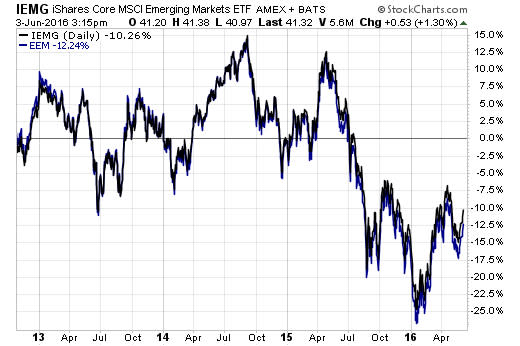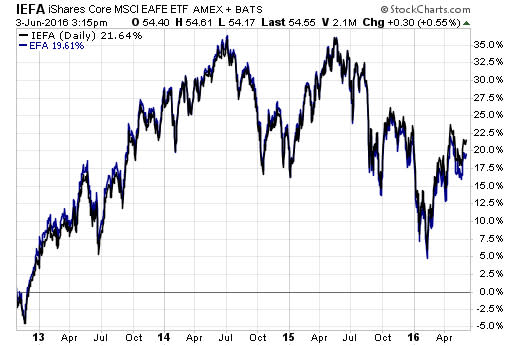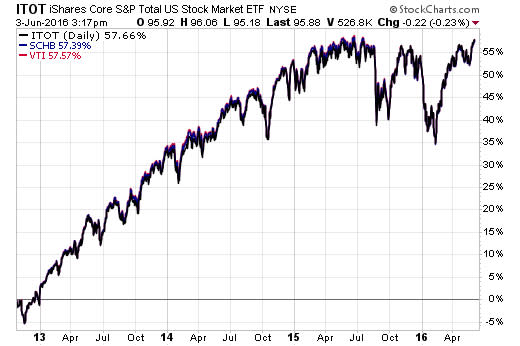iShares Core: ETF Cannibalism That Worked
iShares first unveiled its Core lineup of ETFs in the fall of 2012, and nearly four years later, it’s clear that the idea to repackage some ETFs and create new ones under the much-cheaper Core brand was a smart one from an asset-gathering perspective.
Here’s an example: the iShares Core MSCI Emerging Markets ETF (IEMG | A-98). The fund competes directly with another iShares ETF—the well-known 13-year-old veteran iShares MSCI Emerging Markets ETF (EEM | B-100).
But IEMG’s MSCI-linked portfolio of emerging market companies covering 99% of market capitalization—which is broader than EEM’s exposure—has a 0.16% expense ratio. EEM charges 0.69%. That’s $16 per $10,000 versus $69 per $10,000 invested for exposure to the same segment offered by the same fund provider. And trading costs on both funds is pretty negligible.
It’s no surprise, then, to see that since it came to market in October 2012, IEMG has gathered more than $12.5 billion in net inflows—despite emerging markets’ difficult few years in terms of performance—while EEM has experienced $8.7 billion net redemptions in the same period.

Today IEMG has $11.15 billion in total assets gathered in little more than four years (representing inflows and performance), slowly but consistently chipping away at EEM’s dominance, which today is increasingly a vestige of what it once was. EEM has $21.7 billion in assets—a far cry from the nearly $50 billion it commanded when IEMG first came to market.
Cheaper & Broader Exposure
"It doesn't take a rocket scientist to understand why investors are dropping EEM for IEMG. It’s four times cheaper, plus it tracks twice the number of stocks. It's like going from the iPhone 1 to the 6s,” Bloomberg’s ETF analyst Eric Balchunas said.
“While there are some massive institutions or traders who think they need EEM's $1.8 billion a day in volume, IEMG is plenty liquid nowadays for the vast majority of investors, as it trades over $100 million at a penny spread," he said.
The original lineup of Core funds launched in 2012 included four new strategies and six existing iShares ETFs that had their names changed and their fees slashed to meet Core’s “dirt cheap” distinction. Today that family of ETFs includes 24 funds tapping into everything from equities to bonds to asset allocation strategies.
Some Competing Funds Grow Together
Not all launches have necessarily taken market share from competing iShares ETFs so deliberately as IEMG has. Consider, for instance, the iShares Core MSCI EAFE ETF (IEFA | A-94).
The fund goes head-to-head with the iShares MSCI EAFE ETF (EFA | A-91), which has some $60 billion in total assets and has been around since 2001.
But IEFA carries a 0.12% expense ratio—less than half EFA’s 0.33% price tag. And since it came to market in 2012, it has grown to become an $11.7 billion fund. IEFA, as with IEMG, offers nearly twice as many securities in its index as EFA.
A look at asset flows for both funds shows that IEFA and EFA have had solid net creations in the past four years. In fact, EFA has gathered more assets—$20 billion versus $12 billion for IEFA—during that period.
But even then, from the perspective of percentage of total assets, IEFA’s growth has been more significant than EFA’s, as many investors continue to pour money into the cheaper alternative.

Core A Reaction To Falling Fees
The whole idea of Core stemmed from growing investor awareness regarding fees. The ETF structure is partly known for being low cost, and many providers had been doing a great job at pushing fees lower and lower as their asset base grew.
That was particularly the case when it came to Vanguard. By design, Vanguard ETFs are a share class of its mutual funds, and asset growth equates to lower fees. The success of the firm’s plain-vanilla ETFs—and the resulting lower fees on its funds—became a benchmark of sorts for the industry of just how low prices could go.
That type of pressure only picked up once ETF players like Charles Schwab aggressively entered the market, and offered some of the cheapest-class ETFs across multiple segments. BlackRock’s iShares has been the No. 1 provider for years, but it hadn’t been known for its low fees necessarily. Core changed that.
iShares again slashed fees on some of these very same funds later. At that time, the move made the iShares Core S&P Total Stock Market ETF (ITOT | A-100) the cheapest equity ETF in the U.S., at 0.03% in expense ratio, undercutting both the Schwab U.S. Broad Market (SCHB | A-100) at 0.04%, and the Vanguard Total Stock Market (VTI | A-100) at 0.05%.

Charts courtesy of StockCharts.com
The industry perceived iShares’ bold move as a commitment to attracting investor dollars with low price tags.
"From a business perspective, BlackRock was smart to launch the Core series to deal with the Vanguard effect,” Balchunas said. “Because as both Steve Jobs and Jeff Bezos have said, it's better to cannibalize yourself than have someone else do it."
iShares today has $862 billion in total ETF assets, its closest competitor being Vanguard, with $526 billion.
Contact Cinthia Murphy at cmurphy@etf.com.
Recommended Stories

 Yahoo Finance
Yahoo Finance 